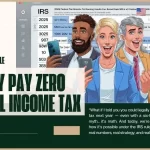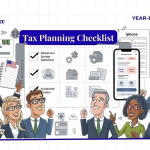Trump’s No-Income-Tax Plan: Imagine keeping every dollar of your paycheck—no IRS withholdings, no April 15th scramble. That’s the vision behind former President Donald Trump’s controversial proposal to eliminate federal income taxes, which currently fund49.3% of government revenue(U.S. Treasury, 2024). But like removing a cornerstone from a building, this radical change would send shockwaves through your investment portfolio.
Beyond the headline-grabbing promise, here’s how this policy could reshape your financial strategy—from retirement accounts to international stocks.
1. Higher After-Tax Investment Returns (But Hidden Complexities)

The Upside:
- Brokerage accounts become more profitable.Dividends and capital gains currently face taxes ranging from15% to 23.8%. Under Trump’s plan, a 10,000 stock∗∗10,000stockgainwouldstay∗∗would stay 10,000** instead of shrinking to $7,620 for top earners (IRS, 2024).
- Example:A rental property generating $ 50,000/year in profit would no longer lose $ 50,000/year in profit; it would also no longer lose $12,500 to taxes (in a 25% bracket), allowing forfaster reinvestment.
The Catch:
- Retirement accounts face uncertainty.Traditional IRAs and 401(k)s rely on tax deferrals. Without income taxes, these might shift toRoth-style accounts, which allow for post-tax contributions and tax-free withdrawals. Employers could restructure benefits—your 3% match might change (Investopedia, 2025).
2. More Cash to Invest—Or Higher Costs Elsewhere?

Immediate Liquidity Boost:
- A family earning75,000/year∗∗would keep an extra∗∗75,000/year∗∗would keep an extra∗∗11,250 annually(15% effective rate). This could turbocharge dollar-cost averaging into index funds.
| Income Level | Current Avg. Tax Rate | Potential Annual Savings |
|---|---|---|
| $50,000 | 12% | $6,000 |
| $200,000 | 24% | $48,000 |
Reality Check:
- Trump proposes replacing lost revenue withtariffs. When 25% tariffs on Canadian aluminum took effect in 2025, Ford increased the prices of its trucks by$1,800(Bloomberg, 2025). Your investment gains might be offset by inflation.
3. Market Volatility From Tariff Whiplash

Tariffs are Trump’s stated replacement for income taxes—and they’ve already moved markets:
- March 2025:20% Chinese tariff announcements triggered a7% S&P 500 dip.
- April 2025:The USMCA tariff pause caused semiconductor stocks to rally by 12%(CNBC, 2025).
International Investments at Risk:
- AGerman automaker ETFcould plummet if 27% EU tariffs materialize. Even domestic manufacturers relying on imported steel face uncertainty (WSJ, 2025).
Minimize your tax liabilities – Capital Gains Tax Simplified: Short-Term vs. Long-Term & Ways to Reduce Your Tax Bill
4. The 401(k) Dilemma: Fewer Tax Incentives

Today’s pre-tax retirement contributions reduce taxable income. Without income taxes:
- Employers might:
- Shift toRoth 401(k)s(post-tax contributions).
- Replace matches with taxable bonuses.
- Cut benefits altogether, citing the loss of tax advantages (Fidelity, 2025).
Silver Lining:Simplified rules could encourage more small businesses to offer plans.
Know more about Significant Changes Coming to Your 401K Plans in 2025: What You Need to Know
5. Real Estate Squeeze: Higher Rates, Fewer Deductions

Trump’s plan coincides with GOP proposals to:
- Cap **mortgage interest deductions at 500,000∗∗(down from 500,000∗∗(down from 750,000).
- Eliminateproperty tax deductions(Tax Foundation, 2025).
With potential tariff-induced inflation pushing mortgage rates toward8%, REITs and homebuilders face headwinds; however, the absence of capital gains taxes could boost flipping activity.
Also read, How to Legally Lower Your Property Taxes in 2025: 12 Effective Strategies
FAQs: Your Top Questions Answered

1. How would eliminating income taxes affect my 401(k)?
Traditional 401(k)s rely on pre-tax contributions. If income taxes are eliminated, these accounts may transition toRoth-style structures,featuring post-tax contributions and tax-free withdrawals. Employers would need to redesign benefits (IRS Retirement Plans).
2. Would tariffs really replace lost income tax revenue?
Economists are skeptical. In 2024, income taxes generated$2.1 trillion, accounting for 49.3% of federal revenue. Tariffs historically raisefar lessand often lead to higher consumer prices (Congressional Budget Office, 2024).
3. Are there protections for retirees?
Trump has floatedexempting Social Security from taxes, but 37% of beneficiaries already pay $0 on benefits. High-earning retirees might benefit most (SSA, 2025).
4. What happens to tax-loss harvesting?
Without capital gains taxes, offsetting losses becomes irrelevant. This could reduce a key risk-management tool for active investors (Investopedia Guide).
5. Will state taxes still apply?
Yes. States likeCalifornia and New Yorkhave their own income taxes. Municipal bonds could retain value for residents in high-tax states (NCSL, 2025).
Actionable Takeaways

- Diversify internationally with caution—tariff targets are subject to frequent shifts.
- Audit employer benefits—expect 401(k) rule changes.
- Consider municipal bonds—if state taxes are retained, their tax-free status remains important.
- Watch inflation hedges—commodities and TIPS may gain importance.
- Consult a fiduciary—transition periods present opportunities for effective planning.
Disclosure:This analysis assumes full income tax elimination. Actual legislation may include phase-ins or exceptions. Consult a CPA for personal advice.
Additional Resources
Would you like further breakdowns of sector-specific impacts (e.g., tech, healthcare, etc.)? Let us know in the comments!
Thank you for reading this post, don't forget to subscribe!






